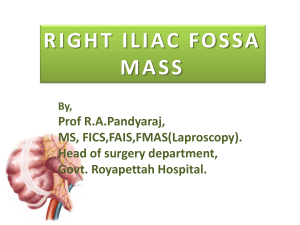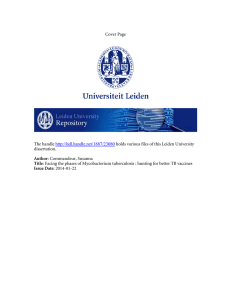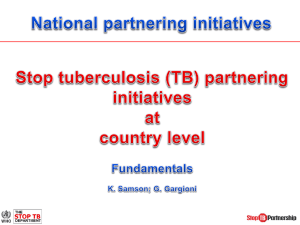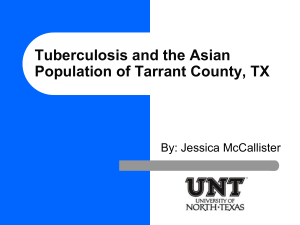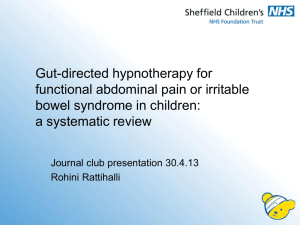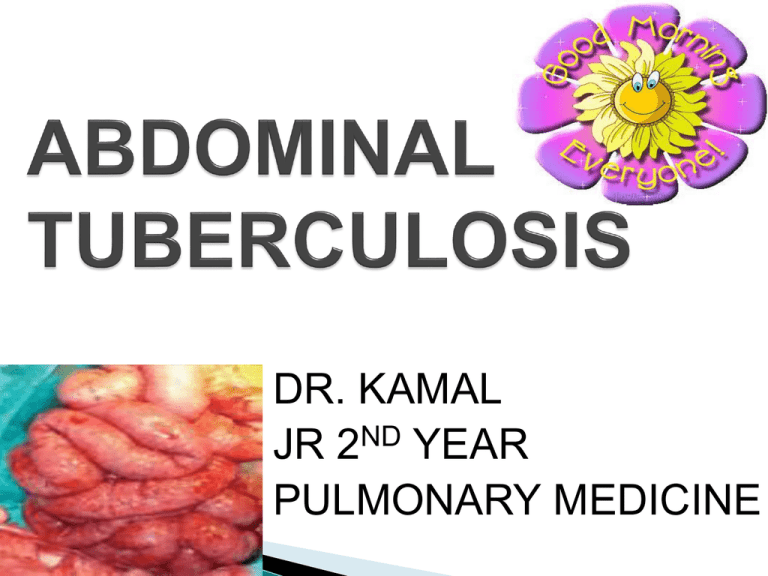
DR. KAMAL
JR 2ND YEAR
PULMONARY MEDICINE
GASTROINTESTINAL TUBERCULOSIS
Tuberculosis enteritis as a complication of
pulmonary
T.B.
was
appreciated
by
HIPPOCRATESs in the 5th century B.C.
Diarrhea attacking a
person with phthisis is a
mortal symptom
(Walsh, 1909)
Abdominal TB can involve any part of GIT from
mouth to anus, the peritoneum and pancreatobilliary system.
Total EP TB accounts for about 10-12% of total
no. of TB cases, out of which 11-16% are
abdominal koch.
Sixth most frequent EP TB after lymphatics,
genitourinary, bone & joint, milliary & meningeal
TB.
Caused by M. tuberculosis, M. bovis & NTM.
Age group 20-40 most commonly affected & slight
female preponderance has been described.
HIV & TB
• Before era of HIV infection > 80% TB was
confined to lung
• Extrapulmonary TB increases with HIV
• 40 –60% TB in HIV+ pt are extrapulmonary
• Globally, proportion of co-infected pt > 8 %
• ~ 0.4 million people in India are co-infected.
• In one study, 16.6% abdominal TB pt in
Bombay was HIV +.
PATHOGENESIS
Mechanisms by which M. tuberculosis reach the GIT:
Hematogenous spread from primary lung focus
Ingestion of bacilli in sputum from active pulmonary focus.
Direct spread from adjacent organs.
Via lymph channels from infected LN
Rare Mechanism:
Contiguous spread of infection from a fallopian tube
TB peritonitis as complication of peritoneal dialysis
DISTRIBUTION OF TUBERCULOUS LESIONS
Ileum > caecum > ascending colon > jejunum
>appendix > sigmoid > rectum > duodenum
> stomach > oesophagus
• More than one site may be involved
Most common site - ileocaecal region
Increased physiological stasis
Increased rate of fluid and electrolyte absorption
Minimal digestive activity permitting greater contact time
between the organism & mucosal surface.
Abundance of lymphoid tissue at this site(peyer’s
patches) & microfold cell ( M cell )
Most active site of inflammation is submucosa
Bacilli in glands
Inflamatory reaction
Phagocytes carry Bacilli in Peyer’s patch
formation of tubercles
Necrosis of tubercles
Enlarges
Endarteritis, edema & sloughing Ulcer formation&
Accumulation of collagenous tissue
Thickening
& stenosis
It can be acute or chronic
ACUTE TUBERCULOSIS PERITONITIS
Present as acute abdomen & are often subjected to
emergency surgery
On opening abdomen , straw colored fluid may be
present & tubercles may be found to be scattered
on the peritoneum & greater omentum.
OMENTUM SCATTERED
WITH TUBERCLES
ASCITIC FORM : Insidious in onset , abdominal
pain usually absent , rolled up greater omentum
infiltrated with tubercles may be felt as transverse
mass.
ENCYSTED(LOCULATED ) FORM: There is
localized swelling & diagnosis is usually
retrospective .
FIBROUS FORM: Widespread adhesion may
cause coils of intestine to be matted together &
distended which act as blind loop leading to
steatorrohoea, malabsorpation syndrome &
abdominal pain.
It is of following types:
ULCERATIVE:
Usually occur in adults who are malnourished
Ulcers may b solitary or multiple & usually lies
transverse to the long axis of the gut girdle.
Healing & fibrosis of the ulcers lead to formation of
napkin ring stricture & obstructive symptoms
Formation of fistula is there
TRANSVERSE ULCER
Usually occur in young adult who are relatively
well nourished with low volume infection by less
virulent organism.
Caecum is most commonly affected site
There is extensive fibrosis & inflammation that
often result in adherance of bowel , mesentry ,
lymph node into the mass.
ULCEROHYPROTROPHIC FORM:
Display features both of ulcerative & hypertrophic
form
Less common form of intestinal TB
Very similar to ULCERATIVE COLITIS
SCLEROTIC FORM
It is associated with stricture formation
Resected portion of illeocaecalTB
Abdominal pain is the most common symptom & is
most commonly located in right lower quadrant of
abdoman. Patient with intestinal obstructio has cramp
like character.
Diarrhoea : 11-20% of patient . Liquid to semisolid
stool passed 6-8 times a day. Mucus is usually
present. Diarrhoea alternating with constipation is
present also present in some patient.
Constitutional symptoms: fever , malaise , weight
loss, anorexia.
Other symptoms: moving lump in abdomen , nausea,
vomiting, malaena & constipation , menstural
abnormalities.
Most patient are ill & malnourished.
Tenderness may be present mostly in right iliac
fossa.
Palpable abdominal mass may be present which
may be due to hyperplastic caecal TB, Lymph
node enlargement & rolled up omentum.
Classic doughy abdomen has been described in
only 6-11% patients.
Signs of peritonitis may be present when there
is intestinal perforation.
Tuberculosis of esophagus
• Rare ~ 0.2% of total cases
• By extension from adjacent LN
• Low grade fever / Dysphagia / Odynophagia /
Midesophageal ulcer
• Mimics esophageal Ca
• Upper part is more commonly involved than lower part
• Endoscopic biopsy is must for confirmation of diagnosis
Rare due to presence of gastric acid and paucity
of lymphoid organ.
Ulcerative form is commonest & ulcers are found
along lesser curvature.
Usually retrospective diagnosis & not suspected
until time of surgery
DUODENAL TUBERCULOSIS
Rare form
Usually present with obstructive symptom which is
more often due to extrinsic obstruction caused by
lymph node or adhesion.
Rare is obstructive jaundice.
Common with ileocaecal TB but isolated is rare
Abdominal perforation may b presenting symptom
Diagnosed mostly on abdominal exploration
ANAL TB
Lesion are ulcerative,lupuoid & verrucus.
Perianal ulcers are shallow with blue undermined
edges
May be associated with inguinal LAD.
Fistula in ano & perianal abscess may be present.
Often associated with miliary TB & more often
occur in immuno-compromised host
May present as acute or chronic pancreatitis or
may mimic malignancy.
FNAC & biopsy are helpful
Occur in disseminated or miliary form of TB
Most common in HIV+ve patients
Common features are left upper quadrant
abdominal pain, weight loss & diarrhea
May Present as hypersplenism or splenic abscess
One or more of the following four criteria must be
fulfilled to diagnose abdominal TB.
Histopathological evidence of tubercles with
caseation necrosis & AFB.
Presence of M tuberculosis in sputum , tissue, or
ascitic fluid.
Clinical , radiological or operative evidence of
proven TB elsewhere with good therapeutic
response.
Good therapeutic response to ATT.
HAEMATOLOGY & SERUM BIOCHEMISTRY
Anaemia, leucopenia with relative lymphocytosis
ESR is raised in 50-100% patients
LAB INVESTIGATION ARE NON SPECIFIC
TUBERCULIN SKIN TEST: Positive in 55-100%
cases.
In area where TB is endemic it neither confirms the
diagnosis nor exclude the diagnosis.
CHEST X RAY: associated pulmonary TB has been
described in 24-28% cases . Evidence of TB in
chest x ray support the diagnosis but normal chest
x ray does not rule it out.
PLAIN X RAY ABDOMEN:
May show
calcified lymph nodes and granulomas
dilated loops with fluid level, dilatation of terminal
ileum
Ascitis
Pneumoperitoneum in intestinal perforation
X ray abdoman
showing calcified LN
Straw coloured
Protein >3g/dL
TLC of 150-4000/µl, Lymphocytes >70%
SAAG < 1.1 g/Dl
Ascitis to blood glucose ratio <1.1g/dl
ZN stain + in < 3% cases
+ culture in < 20% cases
ADA: Adenosine deaminase
ADA is increased due to stimulation of T-cells by
mycobacterial Ag
Serum ADA > 54 U/L
Ascitic fluid ADA > 36 U/L
Ascitic fluid to serum ADA ratio > 0.985
Coinfection with HIV normal or low ADA
False high values seen in malignant ascitis &
chronic kidney disease.
Barium studies
Enteroclysis followed by barium enema is the best
protocol
Increased transit time with hypersegmentation
(chicken intestine) and flocculation is the earliest sign
Localised areas of irregular thickened folds, mucosal
ulceration, dilated segments and strictures
Thickened iliocaecal valve with a broad triangular
appearance with the base towards the caecum
(inverted umbrella sign or (Fleischner’s sign)
Rapid transit and lack of barium retention (Sterlin’s
sign)
Narrow beam of barium due to stenosis(string’s sign)
Conical caecum:- shrunken in size & pulled out of
iliac fossa
Goose neck deformity- loss of normal ileocaecal
angle & terminal dilated ileum appearing from
retracted pulled up caecum
Both Stierlin & String sign is present in crohn’s
disease
Barium oesophagogram-ulcerative
oesophagitis, stricture, pseudo tumour masses,
fistula, sinus, traction diverticulae
Duodenal tuberculosis-segmental narrowing,
widening of the “C” loop due to lymphadenopathy
Group1: Highly s/o intestinal TB if one or more of
the following features are present
a. Deformed ileocaecal valve with dilatation of
terminal ileum
b. Contracted caecum with an abnormal ileocaecal
valve and/or terminal ileum
c. Stricture of the ascending colon with shortening
of and involvement of ileocaecal region
GroupII: Suggestive of intestinal tuberculosis if one
of the following feature present
a.Contracted caecum
b.Ulceration or narrowing of the terminal ileum
c.Stricture of the ascending colon
d.Multiple areas of dilatation, narrowing and matting
of small bowel loops
GroupIII: Non-specific changes
Features of matting, dilatation and mucosal
thickening of small bowel loops
GroupIV: Normalstudy
Chicken intestine: hypersegmentation of
small intestine
Multiple tuberculous strictures small
intestine
Ba. Meal follow-through
Yehia Aly, Cairo University
NARROWING OF INTESTINE:
STRING’s SIGN
Often reveals a mass made up of matted loops of
small bowel with thickened walls, diseased omentum,
mesentery and loculated asites
Fine septae may be seen in the ascitic fluid
Inter loop ascites gives rise to charecteristic “club
sandwitch” appearance
Mesenteric thickening is better detected in the
presence of ascites and is often seen as the “stellate
sign” of bowel loops radiating from its root
In intestinal tuberculosis bowel wall thickening is
usually uniform and concentric as opposed to the
eccentric thickening at the mesenteric border seen in
Crohn’sdisease and the variegated appearance seen
in malignancy
Granulomas or absess in the liver ,pancreas or
spleen
“Pseudo kidney sign” illeocaecal region pulled
upto sub hepatic position
USG ABDOMAN SHOWING FREE
FLUID & LAD
Usg abdoman showing
lymphadenopathy & omental
thickening
CT is better than USG in detecting high dense ascites
of high attenuation 25-45 HU
Abdominal lymphadenopathy is the commonest
manifestation of tuberculosis on CT
Retroperitoneal, peripancreatic, portahepatis, and
mesenteric/omental lymph node enlargement may be
evident
Caseous necrotising lymph node appears as low
attenuating necrotic centers and thick enhancing
inflammatory rim
Omental thickening is well seen as omental cake
appearance . A fibrous wall can cover the omentum
due to long standing inflammation & is called
“omental line”. An omental line is less common in
malignancy
Preferential thickening of the medial caecal wall
with an exophytic mass engulfing the terminal
ileum associated with massive lymphadenopathy
is characteristic of tuberculosis
Short segments of mural thickening with normal
intervening bowel associated with ileocaecal
involvement strongly suggest tuberculosis
CT SCAN OF PELVIS
SHOWING ASCITIS &
OMENTAL MASS
CIRCUMFERE
NTIAL
THICKENING
OF CAECUM
&
NARROWING
OF TERMINAL
ILEUM
CT SCAN OF ABDOMAN
SHOWING LOCULATED
ASCITIS & MESENTRIC LN &
STRANDS
MRI:-has no added advantage
Endoscopy
Colonoscopy:- it is excellent tool for diagnosis.
Ulceration is the most common finding. Ileocaecal valve may
edematous or deformed. Nodules, ulcers, pseudopolyps may be seen.
Mucosal nodules of variable sizes & ulcers in a discreate segment of
colon , 4-8 cm in length are pathognomic. A combination of histology
and culture can establish diagnosis in 80% of cases
Fine needle aspiration cytology : it can be done from
lymph nodes , abscesses ,& focal lesion of viscera.
Peritoneal biopsy- it can be blind or open parietal peritoneal biopsy
under LA.
Laparoscopy:-most effective method. 80 to 95% diagnostic
accuracy. Characteristic finding include multiple, yellowish-white miliary
nodules over peritoneum, erythematous, thickened and hyperemic
peritoneum , turbid ascitis & adhesions.
chances of perforation are higher when patients with fibroadhesive
disease are subjected to laproscopy.
Bhargava et al used ELISA with monoclonal Ab
against 38 kDa protein
Found a senstivity of 81% and specificity of 88% &
diagnostic accuracy of 84%.
However, ELISA remain positive even after
therapy, the response to mycobacteria is variable
& its reproducibility is poor.
PCR:
Amplification of 340 bp nucleotide seq located
within the 38 kDa protein gene of M. tuberculosis
Diagnostic accuracy as a single test is questionable
39
Medical treatment
Earlier 8-12 month of ATT given now it has been observed
that A six month short-course ATT is as effective as
standard 12 month regimen
Corticosteroids-role not well established
Surgical treatment
To manage complication such as
Obstruction , perforation and
massive hemorrhage
Strictures by stricturoplasty or resection
Perforation by resection and anastomosis
Bypass surgery not indicated
Surgery followed by full course of ATT
Malabsorption
Coeliac disease
Lymphoma
Immunoproliferative small intestinal diseae
Crohn’s disease
MASS
Appendicular mass
Actinomycosis
Caecal carcinoma
Lymphoma
Ascites
Cardiac disease
Renal disease
Hepatic disease
malignacy
1. OBSTRUCTION : Most common complication
Pathogenesis
◦ Hyperplastic caecal TB
◦ Strictures of the small intestine--- commonly multiple
◦ Adhesions
◦ Adjacent LN involvement traction, narrowing and
fixation of bowel loops.
2. PERFORATION:
after typhoid
2nd commonest cause
Usually single and proximal to a stricture
Clue - TB Chest x-ray, h/o SAIO
Pneumoperitoneum in ~ 50% cases
3. MALABSORPTION:
Pathogenesis
bacterial overgrowth in stagnant loop
bile salt deconjugation
diminished absorptive surface due to ulceration
involvement of lymphatics and LN
Medical treatment
. Earlier 8-12 month of ATT given now it has been observed
that A six month short-course ATT is as effective as
standard 12 month regimen
Corticosteroids-role not well established
Surgical treatment
To manage complication such as
Obstruction,perforation and
massive hemorrhage
Strictures by stricturoplasty or resection
Perforation by resection and anastomosis
Bypass surgery not indicated
Surgery followed by full course of ATT
43
CROHN’s DISEASE
TUBERCULOSIS
CXRAY show previous or
active TB.
Feautres like arthralgia, arthritis,
eythema nodosum are more
common
Involvement of fewer than 4
segments, patulous ileocaecal
valve,transverse ulcers , scars
& pseudopolyp .
Granulomas :
Multiple(mean no. 5.35 per site),
large(>0.05 mm^2), confluent
& in submucosal region
Preferential thickening of
ileocaecal valve & medial wall
of caecum
Anorectal fissures, longitudnal
ulcers, apthous ulcers,
cobblestone
Infrequent(mean no : 0.75) ,
small(95µm) & mucosal
granuloma
Thickening is more uniform &
lesser thickening of the bowel
Abdominal koch is most difficult type of TB to
diagnose & its reoccurence is even more difficult
to diagnose as
BMFT changes like pulled up caecum, fibrosis,
remain even after initial treatment
There are no specific sign & symptom & mimicks
many other disease
Often patient do not have previous record to
differentiate between new & old finding
No role of Montoux in reoccurence & ELISA also
remain positive even after treatment.
HOW TO DIAGNOSE REOCCURENCE
Usually on basis of clinical signs & symptoms
High clinical suspicion
Proved from biopsy / HPE or culture positive
As one of the diagnostic criteria is RELIEF OF
SYMPTOMS WITH THERAPEUTIC TRIAL OF
ATT so sometime diagnosis is retrospective

